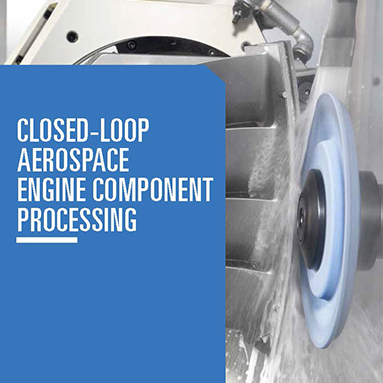As the commercial jet market continues to grow with orders and deliveries at record levels, production rates are soaring to historic highs to satisfy demand and reduce the backlog of aerospace engine orders. To meet these projections, manufacturers are putting equipment in place and proving out processes in advance, all while engaging in full production on the orders already coming through. This environment has led to the growing adoption of closed-loop manufacturing processes to help maintain strict quality and accuracy requirements while making large quantities of aircraft engine parts with little to no scrap.
Closed-loop processing establishes a mechanism that helps manufacturers become more efficient without needing much operator intervention. The quality and accuracy of the parts are improved by correlating between measuring devices and manufacturing devices. The machines communicate and react to each other, correcting any errors and making improvements without human intervention while also keeping the process on track.
Probing to secure a best fit before machining the part ensures quality. Then the data from the probing is processed and checked before loading another part. The feedback that occurs throughout the process creates the closed loop
The Most Important Decision: Select the Right Partner
The planning, specification and implementation of closed-loop manufacturing is a complex process, making it crucial for manufacturers to identify a supply chain partner with deep planning and engineering experience in the development of these systems.
A strong supplier must be able to execute a turnkey package, managing the automation, software, mechanical and electrical engineering, and provide localized support. The supplier should be highly experienced in statistical process control and familiar with all critical technologies incorporated within the system, including the machinery, probes, coordinate-measure machines (CMM) and software. By selecting the right supplier, manufacturers can have confidence that the application is programmed and configured appropriately, the process is debugged, and on-site training is provided post-installation.
Lay Out and Automate the Cell
Next, manufacturers must decide whether to implement a closed-loop process into an automated or non-automated cell.
Automated machining systems have been key to global competitiveness for many manufacturers and are configured to meet a variety of needs across nearly all industries. While the automated systems may have a slightly higher initial cost, they can dynamically improve output at a lower cost per part. In fact, some companies use automation to increase machining efficiency and capacity to gain extra revenue potential, to save direct labor costs and setup times, or to improve quality by eliminating scrap.
In a closed-loop environment, it is important to choose a provider with proven experience in automation. Moreover, when it comes to machine selection, with floor space at a premium in most shops, the automation cell design should optimize square footage. Other considerations to be made include equipment stacking, maintenance access and workflow through the cell.
Test and Check the Process
Integrating a closed-loop system requires more than just the right equipment; it demands detailed engineering support before and after equipment installation to conduct testing and process checks.
Process checks should be established during the system design process to manage the quality of parts, and to make sure every part detail and requirement is achievable. Manufacturers should rely on their supplier to provide recommendations on the best machine package and tooling package to meet production requirements, as well as programming of coolant trajectories and development of fixture designs. A quality supplier should be able to help manufacturers model and predict outcomes through proper process and fixture testing, 3-D modeling and time studies.
Conclusion
Ultimately, using closed-loop manufacturing technology not only reduces machining time but also increases accuracy and quality. In today’s global environment, manufacturers must gain every competitive advantage they can.
The right supplier partnership can make designing and implementing a closed-loop process less complicated. How do you know when you’ve found the right technology provider? Be sure to ask whether they can provide:
- A single source for engineering and the capability to plan and execute the entire design and implementation process
- Machines that include milling, grinding and electrical discharge machining (EDM), along with 5-axis capability
- Turnkey processes with the reliability and stability to reproduce parts day in and day out with minimal adjustments
- Testing, 3-D modeling and time studies prior to setting up the machine and running parts
- Automation software and hardware that smoothly integrates with your machines
- Monitoring of key machining processes to maintain the closed-loop process
By having the proper resources in place to execute this type of solution, manufacturers can ensure a smooth and accurate process.

Learn more about the process of defining a closed-loop manufacturing process and what to look for when selecting the right supplier in Makino’s complimentary white paper, “Closed-Loop Aerospace Engine Component Processing.”
Visit makino.com/whitepapers/closedloop